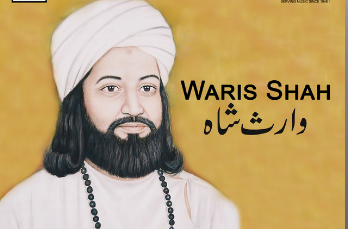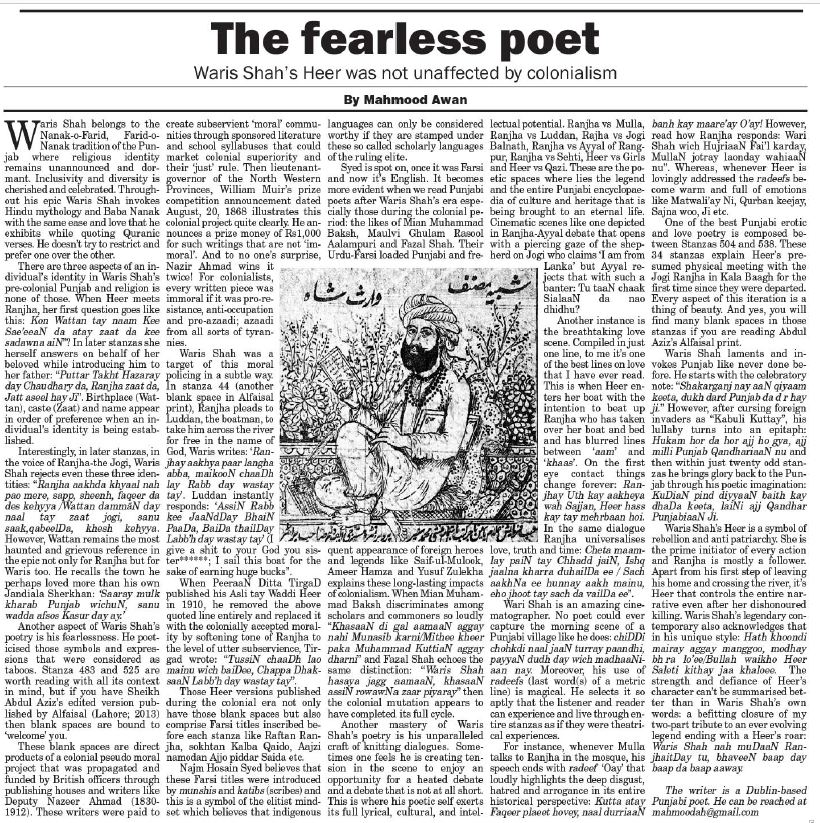Mahmood Awan (The News on Sunday, 25th September 2016)
Waris Shah belongs to the Nanak-o-Farid, Farid-o-Nanak tradition of the Punjab where religious identity remains unannounced and dormant. Inclusivity and diversity is cherished and celebrated. Throughout his epic Waris Shah invokes Hindu mythology and Baba Nanak with the same ease and love that he exhibits while quoting Quranic verses. He doesn’t try to restrict and prefer one over the other.
There are three aspects of an individual’s identity in Waris Shah’s pre-colonial Punjab and religion is none of those. When Heer meets Ranjha, her first question goes like this: Kon Wattan tay naam Kee Sae’eeaN da atay zaat da kee sadawna aiN“? In later stanzas she herself answers on behalf of her beloved while introducing him to her father: “Puttar Takht Hazaray day Chaudhary da, Ranjha zaat da, Jatt aseel hay Ji“. Birthplace (Wattan), caste (Zaat) and name appear in order of preference when an individual’s identity is being established.
Interestingly, in later stanzas, in the voice of Ranjha-the Jogi, Waris Shah rejects even these three identities: “Ranjha aakhda khyaal nah pao mere, sapp, sheenh, faqeer da des kehyya /Wattan dammãN day naal tay zaat jogi, sanu saak,qabeelDa, khesh kehyya. However, Wattan remains the most haunted and grievous reference in the epic not only for Ranjha but for Waris too. He recalls the town he perhaps loved more than his own Jandiala Sherkhan: ‘Saaray mulk kharab Punjab wichuN, sanu wadda afsos Kasur day ay.’
Another aspect of Waris Shah’s poetry is his fearlessness. He poeticised those symbols and expressions that were considered as taboos. Stanza 483 and 525 are worth reading with all its context in mind, but if you have Sheikh Abdul Aziz’s edited version published by Alfaisal (Lahore; 2013) then blank spaces are bound to ‘welcome’ you.
These blank spaces are direct products of a colonial pseudo moral project that was propagated and funded by British officers through publishing houses and writers like Deputy Nazeer Ahmad (1830-1912). These writers were paid to create subservient ‘moral’ communities through sponsored literature and school syllabuses that could market colonial superiority and their ‘just’ rule. Then lieutenant-governor of the North Western Provinces, William Muir’s prize competition announcement dated August, 20, 1868 illustrates this colonial project quite clearly. He announces a prize money of Rs1,000 for such writings that are not ‘immoral’. And to no one’s surprise, Nazir Ahmad wins it twice! For colonialists, every written piece was immoral if it was pro-resistance, anti-occupation and pro-azaadi; azaadi from all sorts of tyrannies.
Waris Shah was a target of this moral policing in a subtle way. In stanza 44 (another blank space in Alfaisal print), Ranjha pleads to Luddan, the boatman, to take him across the river for free in the name of God, Waris writes: ‘Ranjhay aakhya paar langha abba, maikooN chaaDh lay Rabb day wastay tay’. Luddan instantly responds: ‘AssiN Rabb kee JaaNdDay BhaiN PaaDa, BaiDa thailDay Labb’h day wastay tay’ (I give a shit to your God you sister******; I sail this boat for the sake of earning huge bucks”.
When PeeraaN Ditta TirgaD published his Asli tay Waddi Heer in 1910, he removed the above quoted line entirely and replaced it with the colonially accepted morality by softening tone of Ranjha to the level of utter subservience, Tirgad wrote: “TussiN chaaDh lao mainu wich baiDee, Chappa DhaksaaN Labb’h day wastay tay“.
Those Heer versions published during the colonial era not only have those blank spaces but also comprise Farsi titles inscribed before each stanza like Raftan Ranjha, sokhtan Kalba Qaido, Aajzi namodan Ajjo piddar Saida etc.
Najm Hosain Syed believes that these Farsi titles were introduced by munshis and katibs (scribes) and this is a symbol of the elitist mindset which believes that indigenous languages can only be considered worthy if they are stamped under these so called scholarly languages of the ruling elite.
Syed is spot on, once it was Farsi and now it’s English. It becomes more evident when we read Punjabi poets after Waris Shah’s era especially those during the colonial period: the likes of Mian Muhammad Baksh, Maulvi Ghulam Rasool Aalampuri and Fazal Shah. Their Urdu-Farsi loaded Punjabi and frequent appearance of foreign heroes and legends like Saif-ul-Mulook, Ameer Hamza and Yusuf Zulekha explains these long-lasting impacts of colonialism. When Mian Muhammad Baksh discriminates among scholars and commoners so loudly “KhasaaN di gal aamaaN aggay nahi Munasib karni/Mithee kheer paka Muhammad KuttiaN aggay dharni” and Fazal Shah echoes the same distinction: “Waris Shah hasaya jagg aamaaN, khasaaN assiN rowawNa zaar piyaray” then the colonial mutation appears to have completed its full cycle.
Another mastery of Waris Shah’s poetry is his unparalleled craft of knitting dialogues. Sometimes one feels he is creating tension in the scene to enjoy an opportunity for a heated debate and a debate that is not at all short. This is where his poetic self exerts its full lyrical, cultural, and intellectual potential. Ranjha vs Mulla, Ranjha vs Luddan, Rajha vs Jogi Balnath, Ranjha vs Ayyal of Rangpur, Ranjha vs Sehti, Heer vs Girls and Heer vs Qazi. These are the poetic spaces where lies the legend and the entire Punjabi encyclopaedia of culture and heritage that is being brought to an eternal life. Cinematic scenes like one depicted in Ranjha-Ayyal debate that opens with a piercing gaze of the shepherd on Jogi who claims ‘I am from Lanka’ but Ayyal rejects that with such a banter: Tu taaN chaak SialaaN da nao dhidhu?
Another instance is the breathtaking love scene. Compiled in just one line, to me it’s one of the best lines on love that I have ever read. This is when Heer enters her boat with the intention to beat up Ranjha who has taken over her boat and bed and has blurred lines between ‘aam’ and ‘khaas’. On the first eye contact things change forever: Ranjhay Uth kay aakheya wah Sajjan, Heer hass kay tay mehrbaan hoi. In the same dialogue Ranjha universalises love, truth and time: Cheta maamlay paiN tay Chhadd jaiN, Ishq jaalna kharra duhailDa ee / Sach aakhNa ee hunnay aakh mainu, eho jhoot tay sach da vailDa ee“.
Wari Shah is an amazing cinematographer. No poet could ever capture the morning scene of a Punjabi village like he does: chiDDi chohkdi naal jaaN turray paandhi, payyaN dudh day wich madhaaNiaan nay. Moreover, his use of radeefs (last word(s) of a metric line) is magical. He selects it so aptly that the listener and reader can experience and live through entire stanzas as if they were theatrical experiences.
For instance, whenever Mulla talks to Ranjha in the mosque, his speech ends with radeef ‘Oay’ that loudly highlights the deep disgust, hatred and arrogance in its entire historical perspective: Kutta atay Faqeer paleet hovey, naal durriaaN banh kay maare’ay O’ay! However, read how Ranjha responds: Wari Shah wich HujriaaN Fai’l karday, MullaN jotray laonday wahiaaN nu”. Whereas, whenever Heer is lovingly addressed the radeefs become warm and full of emotions like Matwali’ay Ni, Qurban keejay, Sajna woo, Ji etc.
One of the best Punjabi erotic and love poetry is composed between Stanzas 504 and 538. These 34 stanzas explain Heer’s presumed physical meeting with the Jogi Ranjha in Kala Baagh for the first time since they were departed. Every aspect of this iteration is a thing of beauty. And yes, you will find many blank spaces in those stanzas if you are reading Abdul Aziz’s Alfaisal print.
Waris Shah laments and invokes Punjab like never done before. He starts with the celebratory note: “Shakarganj nay aaN qiyaam keeta, dukh dard Punjab da dūr hay ji.” However, after cursing foreign invaders as “Kabuli Kuttay”, his lullaby turns into an epitaph: Hukam hor da hor ajj ho gya, ajj milli Punjab QandhariaaN nu and then within just twenty odd stanzas he brings glory back to the Punjab through his poetic imagination: KuDiaN pind diyyaaN baith kay dhaDa keeta, laiNi ajj Qandhar PunjabiaaN Ji.
Waris Shah’s Heer is a symbol of rebellion and anti patriarchy. She is the prime initiator of every action and Ranjha is mostly a follower. Apart from his first step of leaving his home and crossing the river, it’s Heer that controls the entire narrative even after her dishonoured killing. Waris Shah’s legendary contemporary also acknowledges that in his unique style: Hath khoondi mairay aggay manggoo, modhay bhūra lo’ee/Bullah waikho Heer Saleti kithay jaa khaloee. The strength and defiance of Heer’s character can’t be summarised better than in Waris Shah’s own words: a befitting closure of my two-part tribute to an ever evolving legend ending with a Heer’s roar: Waris Shah nah muDaaN RanjhaitDay tu, bhaveeN baap day baap da baap aaway.
Published on 25th September 2016 in The News on Sunday.
https://www.thenews.com.pk/tns/detail/561791-fearless-poet


